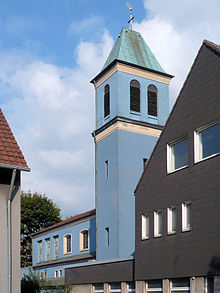St. Maria Immaculata (Borbeck)
The Church of St. Mary Immaculate was a Roman Catholic church building in Essen district Borbeck-Mitte . She left the wafers produced Monastery Borbeck, 2007 was desecrated and set out finally, 2014.
history
origin
The origin of St. Maria Immaculata lies in the Oblate Monastery in Borbeck. Its monastery church was acquired by the Pentecostal community in 1917 . In 1923 the bell tower was built by volunteers under the direction of the building contractor Franz Pothmann.
The church choir was founded in 1926.
At the time of National Socialism and afterwards
On December 8, 1939, the church, together with the rectorates of St. Paulus, St. J. Bosco and St. Franziskus, was raised to the status of rectorate in order to protect the monastery from being accessed by the Gestapo . In particular, the commitment of the dean Johannes Brokamp of St. Dionysius contributed to the success. At that time the church building could accommodate around 350 to 400 people. Nevertheless, the four church bells were confiscated by the National Socialists as a metal donation by the German people .
The building, which was destroyed by two bombs in World War II , was rebuilt from 1947 onwards. About eleven meters were built on the east side, whereby the space for church visitors increased to up to 700 people. On 12 December 1948, the Church by the auxiliary bishop of Cologne was Joseph Ferche consecrated . In 1951 the organ was installed, which was consecrated on January 27, 1952.
In 1968 the Oblate Fathers left Borbeck after 50 years. The old monastery home was laid down in 1973 and the parish hall was built immediately afterwards, the topping-out ceremony of which took place on October 12th of that year. On October 6th, 1974, the parish center was officially handed over.
Bells
Monastery chapel
In 1922, the Petit & Gebr. Edelbrock bell foundry produced a four-part chime for the old monastery chapel of the oblate monastery . The first bell, weighing 324 kilograms and 0.79 meters in diameter, had the striking tone c , the second with 222 kilograms and 0.69 meters had the striking tone d , the third with 126 kilograms and 0.58 meters had the striking tone f and the fourth was 86 Kilograms and 0.5 meters in diameter the strike tone g . They were all confiscated by the National Socialists as metal donations from the German people .
Post-war church
Three new church bells, which were cast by Friedrich Wilhelm Schilling in Heidelberg in October 1958 , replaced the lost ones.
The bell, named Maria , weighed 743 kilograms and was 1.05 meters in diameter, on the f sharp note . This bell of Mary bore the inscription: REGINA SINE LABE ORIGINALI CONCEPTA + ORA PRO NOBIS (Queen, received without original sin, please for us!).
The second bell, named Joseph , weighed 515 kilograms and was 0.93 meters in diameter, with a g sharp note . Its inscription read: CARTRIDGE MORIENTIUM + ORA PRO NOBIS FAC NOS INNOCVAM DECVRRERE VITAM: SITQVE TVO SEMPER TVTA PATROCINIO (Patron saint of the dying, pray for us. Let us lead an innocent life and may it always be safe through your protection.).
The third bell, called Altfride , weighed 342 kilograms and had a diameter of 0.8 meters, hitting h . It bore the inscription: SANCTE ALTFRIDE: FVNDATOR ASSINDIAE + ORA PRO EPISCOPO ET CLERO ET POPVLO VNIVERSO (St. Altfride, founder of Assinda + request for the bishop, the clergy and the whole people.) On the opposite side of the bell was: ECCE SACERDOS MAGNVS QVI IN DIEBVS SVIS PLACVIT DEO (See, great is the priest who has pleased God in his day.).
Last service and laying down
To meet the declining number of church members at the beginning of the 21st century, the churches felt compelled to close some churches; including the St. Maria Immaculata Church in Essen-Borbeck, where the last service was celebrated on December 8, 2007. On February 1, 2008, the parish of St. Maria Immaculata was integrated into the parish of St. Dionysius. In May and June 2014 the church building was demolished and a retirement home was built on the property.
Some liturgical objects went into the sacristy of St. Dionysius. The baptismal font became the actual holy water font under the organ stage, where the altar cross of the St. Maria Immaculate Church also found its place. The statue of Maria Immaculata is now in the passage chapel in the right aisle of St. Dionysius. Components of the organ complement the new organ of St. Michael in Dellwig , which was consecrated there in September 2014.
Individual evidence
- ↑ a b c d e parish of St. Dionysius: History of St. Maria Immaculata ; Retrieved April 4, 2016
- ↑ a b Bell books of the Diocese of Essen: St. Maria Immaculata, Borbeck ( Memento of the original from September 25, 2013 in the Internet Archive ) Info: The archive link was inserted automatically and has not yet been checked. Please check the original and archive link according to the instructions and then remove this notice. ; Retrieved April 4, 2016
- ↑ DerWesten.de of June 3, 2014: Church in Essen torn down ; Retrieved April 4, 2016
- ^ Parish of St. Dionysius: Inauguration of the new organ in St. Michael on September 28 , 2014 ; Retrieved April 4, 2016
Coordinates: 51 ° 28 ′ 3.1 ″ N , 6 ° 56 ′ 47.7 ″ E
